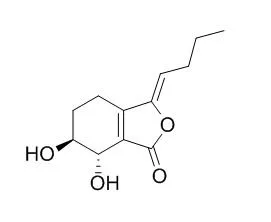| Description: |
Senkyunolide I may be an active component of L. chuanxiong, traditionally used to treat migraine, it can protect rat brain against focal cerebral ischemia-reperfusion injury by up-regulating p-Erk1/2, Nrf2/HO-1 and inhibiting caspase 3, the neuroprotective mechanisms of itI are associated with its anti-oxidation and anti-apoptosis properties. Senkyunolide I can reduce the metamorphose damage of the RBC caused by ConA, the aggregation of the RBC can be alleviated by it.
|
| In vivo: |
| Brain Res. 2015 Apr 24;1605:39-48. | | Senkyunolide I protects rat brain against focal cerebral ischemia-reperfusion injury by up-regulating p-Erk1/2, Nrf2/HO-1 and inhibiting caspase 3.[Pubmed: 25698615] | Oxidative damage and apoptosis are critical factors contributing to neuronal death during a stroke. The aim of the present study was to evaluate the neuroprotective effects of Senkyunolide I (SEI) on focal cerebral ischemia-reperfusion (I/R) injury in rats, and investigate the underlying mechanisms.
METHODS AND RESULTS:
Male Sprague-Dawley rats were subjected to transient middle cerebral artery occlusion (tMCAO) for 2h, followed by 24h reperfusion, and then randomly assigned into four groups: Sham (sham-operated), Vehicle (tMCAO +normal saline), Senkyunolide I-L (tMCAO +SEI 36 mg/kg) and Senkyunolide I-H (tMCAO +SEI 72 mg/kg) groups. Senkyunolide I was administered intravenously, 15 min after occlusion. Neurological deficit, brain edema and infarct volume were detected after 24h of reperfusion. Histological structures of cortices and hippocampus were observed by hematoxylin and eosin staining. Biochemical indexes in the cortex were assayed by colorimetry. The impact of Senkyunolide I on the Nrf2-ARE-interaction was assayed using a luciferase reporter gene. Western blotting was performed to analysis the expressions of proteins related to anti-oxidation and apoptosis. Senkyunolide I administration significantly ameliorated the neurological deficit, reduced the infarct volume and brain edema, reversed the cerebral morphologic damage, decreased the levels of MDA and increased the activities of superoxide dismutase. Furthermore, the high dose Senkyunolide I could significantly activate the Nrf2/ARE pathway by up-regulating the phosphorylation of Erk1/2 and inducing Nrf2 nuclear translocation with enhanced HO-1 and NQO1 expressions. Additionally, treatment with Senkyunolide I remarkably promoted the ratio of Bcl-2/Bax and inhibited the expressions of cleaved caspase 3 and caspase 9.
CONCLUSIONS:
These results suggest that the neuroprotective mechanisms of Senkyunolide I are associated with its anti-oxidation and anti-apoptosis properties. | | J Pharm Biomed Anal. 2013 Jul-Aug;81-82:178-86. | | Identification of senkyunolide I metabolites in rats using ultra performance liquid chromatography/quadrupole-time-of-flight tandem mass spectrometry.[Pubmed: 23666254] | Ligusticum chuanxiong Hort. (Umbelliferae) has been widely prescribed to treat cardiovascular disease in China for centuries. Senkyunolide I is one of the major bioactive components in L. chuanxiong, which shows pharmacological activities against migraines and oxidative damage.
METHODS AND RESULTS:
In this paper, ultra performance liquid chromatography/quadrupole-time-of-flight tandem mass spectrometry (UPLC/Q-TOF-MS) was applied for the rapid analysis of Senkyunolide I metabolites in rats after its intravenous administration. The non-metabolized parent compound and eighteen metabolites from drug-treated samples in rat plasma, urine and bile were identified. Our analysis indicated that methylation, hydration, epoxidation, glucuronidation and glutathione conjugation were the major pathways of Senkyunolide I metabolism in vivo.
CONCLUSIONS:
This study provides important information regarding the metabolism of Senkyunolide I, which will be helpful for understanding its mechanism of action. Furthermore, this work demonstrates the potential of using UPLC/Q-TOF-MS for the rapid and reliable characterization of the metabolites of natural products. |
|






 Cell. 2018 Jan 11;172(1-2):249-261.e12. doi: 10.1016/j.cell.2017.12.019.IF=36.216(2019)
Cell. 2018 Jan 11;172(1-2):249-261.e12. doi: 10.1016/j.cell.2017.12.019.IF=36.216(2019) Cell Metab. 2020 Mar 3;31(3):534-548.e5. doi: 10.1016/j.cmet.2020.01.002.IF=22.415(2019)
Cell Metab. 2020 Mar 3;31(3):534-548.e5. doi: 10.1016/j.cmet.2020.01.002.IF=22.415(2019) Mol Cell. 2017 Nov 16;68(4):673-685.e6. doi: 10.1016/j.molcel.2017.10.022.IF=14.548(2019)
Mol Cell. 2017 Nov 16;68(4):673-685.e6. doi: 10.1016/j.molcel.2017.10.022.IF=14.548(2019)